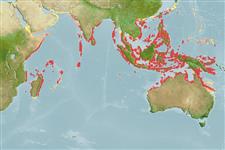|
Scleractinia |
Acroporidae
Environment: milieu / climate zone / depth range / distribution range
Ökologie
Riff-verbunden. Tropical; 36°N - 27°S, 40°E - 154°E (Ref. 846)
Indo-West Pacific.
Length at first maturity / Size / Gewicht / Alter
Maturity: Lm ? range ? - ? cm
Colonies are composed of thin delicate unifacial laminae forming flat or slightly upright whorls or irregular contortions. Corallites are immersed, but clearly visible. Coenosteum: coarse. No papillae. Surfaces of fronds: finely rough appearance. Polyps may be extended during the day. Pale brown or mauve.
Shallow turbid reef environments and lagoons (Ref. 846).
Life cycle and mating behavior
Geschlechtsreife | Fortpflanzung | Ablaichen | Eier | Fecundity | Larven
Members of the class Anthozoa are either gonochoric or hermaphroditic. Mature gametes are shed into the coelenteron and spawned through the mouth. Life cycle: The zygote develops into a planktonic planula larva. Metamorphosis begins with early morphogenesis of tentacles, septa and pharynx before larval settlement on the aboral end.
Veron, J.E.N. 2000. (Ref. 846)
IUCN Rote Liste Status (Ref. 130435)
CITES Status (Ref. 108899)
Not Evaluated
Bedrohung für Menschen
Nutzung durch Menschen
| FishSource |
Tools
Mehr Information
Alter/GrößeWachstumLänge-GewichtLänge-LängeMorphologieLarvenDichte
Internet Quellen
Estimates based on models
Preferred temperature
(Ref.
115969): 27.9 - 29.2, mean 28.7 (based on 344 cells).
Preiskategorie
Unknown.
